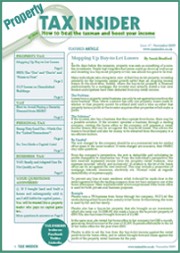Before you go, sign up to our free tax saving email course. Get 7 top property tax saving strategies in your email inbox that will help you save thousands in tax. Unsubscribe any time.
 Mark McLaughlin highlights a potential problem for taxpayers wishing to claim private residence relief on a property disposal. Mark McLaughlin highlights a potential problem for taxpayers wishing to claim private residence relief on a property disposal. Private residence relief (PRR) for capital gains tax (CGT) purposes is potentially very generous. For example, a UK resident individual who is a higher rate taxpayer is liable to CGT on a residential property gain at 28% (for 2016/17). However, if PPR is available in full, the individual’s gain on disposal is not a chargeable gain, so there is no CGT liability. PRR mainly applies to the disposal by an individual of a dwelling house (or of an interest in it) which is, or has at any time in their period of ownership been, their only or main residence (TCGA 1992, s 222(1)). The amount of relief depends on various factors (see ss 223-224); including periods of (actual and deemed) occupation by the individual as a residence (n.b. separate rules (s 223A) apply to disposals of UK residences by non-UK residents, which are beyond the scope of this article). Is it a residence? The above requirement that the dwelling house must have been the individual’s ‘residence’ at some point is often overlooked or misunderstood. Occupation is not necessarily enough to make the property a residence. This point has resulted in many PRR claims by taxpayers failing (e.g. Moore v Revenue and Customs [2010] UKFTT 445 (TC); Bradley v Revenue and Customs [2013] UKFTT 131 (TC)). More recently, in Oliver v Revenue and Customs [2016] UKFTT 796 (TC), the taxpayer (who ran a property letting business) lived in a property (P) with his long-term partner. In spring 2006, the taxpayer and his partner suffered a relationship breakdown, and subsequently agreed to a trial separation. Another property (F) was purchased on 5 January 2007 (with the help of a buy-to-let mortgage). By early March 2007, the taxpayer had instructed agents to put F up for sale. The couple subsequently agreed to try again with their relationship. They went on holiday, and returned to P afterwards. F was sold on 12 April 2007. The taxpayer claimed PRR on the basis that he resided at F as his only or main residence from 5 January 2007 to 12 April 2007, but HM Revenue and Customs (HMRC) disagreed. The First-tier Tribunal concluded (among other things) that the taxpayer may have stayed at F on occasions, but at no stage was it his intention to reside there. The taxpayer’s occupation of F had been a useful stop-gap place to stay that also allowed him to carry out redecoration, clear the flat for photographs and apply for a lease extension necessary for letting. The degree of the taxpayer’s occupation was consistent with his intention to let the flat, and the cost of the lease extension prompted the sale. The taxpayer’s appeal was dismissed. Prove it! It is important for individuals to have reliable evidence to support any claim that the property was intended to be occupied as their residence. The tribunal in Oliver found (on the balance of probabilities) three aspects of the taxpayer’s evidence in particular to be unreliable: 1. a photograph of his daughter in the flat, which the taxpayer later admitted was taken when viewing the flat in 2006, prior to purchasing it; 2. the bills submitted as evidence did not support the taxpayer’s claim that the property was occupied as his residence (e.g. the utility bills would have been issued regardless of the occupation of the flat); and 3. the taxpayer’s partner’s involvement in the purchase was difficult to reconcile with the taxpayer residing at the flat because of their separation. Practical Tip: In seeking to establish that a property was intended to be occupied as a residence, it may be helpful to demonstrate having notified banks, government authorities, utility companies, insurers, etc., accordingly. HMRC’s Capital Gains manual (at CG64545) lists some indicators (albeit in the context of establishing a taxpayer’s main residence for main residence election purposes): • If the individual is married or in a civil partnership, where does the family spend its time? • If the individual has children, where do they go to school? • At which residence is the individual registered to vote? • Where is the individual’s place of work? • How is each residence furnished? • Which address is used for correspondence? o Banks and building societies o Credit cards o HMRC • Where is the individual registered with a doctor/dentist? • At which address is the individual’s car registered and insured? • Which address is the main residence for council tax? Unfortunately, in Oliver the tribunal found that ‘the quality of occupation lacked the assumption of permanence, any degree of continuity or expectation of continuity’ (i.e. tests applied in Goodwin v Curtis [1998] STC 475). This is a sample article from the monthly Property Tax Insider magazine. Go here to get your first free issue of Property Tax Insider. |


 Tax Articles
Tax Articles